Parameter Sensitivity Analysis and Identification of an Improved Symmetrical Hysteretic Model for RC Hollow Columns
Abstract
:1. Introduction
2. Degraded and Pinched Hysteretic Model for RC Hollow Columns
2.1. The Original BWBN Hysteretic Model
2.2. Quasi-Static Experiment of RC HOLLOW Columns
2.3. The Improved BWBN Hysteretic Model
3. Parameter Sensitivity Analysis of the Improved BWBN Model
3.1. Local Sensitivity Analysis
3.1.1. The Procedure of Local Sensitivity Analysis
- We changed only one parameter and kept the other parameters unchanged, followed by NDTHA again. Each parameter was changed by multiplying the current value by (1 + Sr), where Sr is a member of the set −50%, −30%, −20%, −10%, 10%, 20%, 30%, and 50%.
- We took all displacement responses obtained from NDTHA as the evaluation object. The displacement error function Eu can be defined as:
3.1.2. The Results of Local Sensitivity Analysis
3.2. Global Sensitivity Analysis
3.2.1. The Procedure of Global Sensitivity Analysis
- Define the target function as Y = f(X), which can be decomposed into the following form by ANOVA (analysis of variance):
- 2.
- Sobol proposed a variance sensitivity analysis method that can consider the coupling between parameters based on the decomposed variance. The total variance of f(X) defined in this method is:
- 3.
- The Monte Carlo method is used to estimate the variance of the model output and thereby complete the aforementioned global sensitivity analysis procedure.
3.2.2. The Results of Global Sensitivity Analysis
4. Parameter Identification for the RC Hollow Columns
4.1. Review of PSOGSA Algorithm
4.2. Identification of the Hysteretic Model
5. Prediction and Validation of the Improved BWBN Model
5.1. Regression of Hysteretic Model Parameters
- Substitute the coefficients xi in Table 9 into Equations (27) and (28), and the prediction formulas of 10 parameters for BWBN model are obtained. For example,
- 2.
- The design parameters of the hollow column are substituted into the prediction formulas to obtain each hysteretic parameter.
- 3.
- Take the 10 parameters above, along with , and , into the improved BWBN model. Once the loading history is offered, the hysteretic curves of the hollow column can be predicted using such an empirical method.
5.2. Validation of the Empirical Prediction Method
6. Conclusions
- (1)
- The coefficient r introduced to the original BWBN model can reflect the correlation between column stiffness degradation and maximum displacement. r can directly control the residual displacement of the hysteretic model; thus, the accuracy of residual displacement can be improved apart from the existing inelastic behavior, via factors such as strength and stiffness degradation, and a pinching effect.
- (2)
- In the improved BWBN model, , , , and are the core parameters according to both local and global sensitivity analyses; , , , , and are at least important according to local or global sensitivity analysis; and , , and are the parameters that have little influence. In particular, r can be taken as a core parameter if focused on the residual displacement.
- (3)
- The hybrid intelligence algorithm PSOGSA can accurately identify the parameters of the improved BWBN hysteretic model for the rectangular hollow column, which is an efficient and powerful tool for such parameter identification of hysteretic models of other RC members.
- (4)
- Empirical prediction equations were regressed to build the relationship between the BWBN model and design parameters of hollow columns, which can be an efficient and convenient way to obtain hysteretic curves for members without experimental loops. Although the accuracy of the predicted hysteretic loops was slightly lower than that of the directly calibrated loops, it was still sufficient for engineering practice.
- (5)
- Widespread applicability of empirical equations predicting the parameters of the improved BWBN model for the hollow columns should be validated by more experimental tests in the future research.
Author Contributions
Funding
Institutional Review Board Statement
Informed Consent Statement
Data Availability Statement
Acknowledgments
Conflicts of Interest
Nomenclature
| (i) BWBN model | |
| ε | Cumulative hysteretic dissipated energy |
| ν, δν | Strength degradation parameter and degradation rate, respectively |
| η, δη | Stiffness degradation parameter and degradation rate, respectively |
| Fel, Fh | Elastic and hysteretic component of the total restoring force F, respectively |
| k | Initial elastic stiffness |
| n | Sharpness of yield |
| p | Pinching slope |
| q | Pinching initiation |
| r | Peak displacement influencing factor |
| x | Translational displacement |
| z | Hysteretic displacement |
| α | Postyield stiffness ratio |
| β, γ | Hysteresis shape control |
| δψ | Pinching rate |
| ζ1 | Pinching severity control |
| ζ2 | Pinching region control |
| ζs | Measure of total slip |
| λ | Pinching severity |
| λs | Stiffness degradation index |
| ψ | Pinching magnitude |
| ω0 | Natural frequency of the structure |
| (ii) Quasi-static experiment | |
| ηa | Axial load ratio |
| , | Secant stiffness of the positive and negative loading in each cycle, respectively |
| , | Secant stiffness at the equivalent yield point, respectively |
| b1, b2, d | Depth, width and web thickness of hollow cross section, respectively |
| fc | Compressive strength of C40 concrete |
| fy, fys | Yielding strength of longitudinal rebar and stirrup, respectively |
| h | Column height |
| Vy, My | Lateral force and bottom moment at the yielding displacement, respectively |
| μMax | Peak displacement ductility coefficient |
| ρ0 | Longitudinal rebar ratio |
| ρv | Volumetric stirrup ratio |
| (iii) Sensitivity analysis | |
| Overall sensitivity coefficient | |
| Eui | Error function in local sensitivity analysis |
| Sr | Variable of ±50%, ±30%, ±20%, and ±10%, respectively |
| u0 (t), ui (t) | Displacement response of the basic model and changed model, respectively |
| (iv) PSOGSA algorithm and identification of BWBN model | |
| εcon | A small constant |
| , | Weighting factors |
| ai(t) | Acceleration of agent i at iteration t |
| E | Error between Fe(t) and Fm(t) |
| Fe(t), Fm(t) | Measured restoring force and simulated restoring force at each step, respectively |
| Fi(t) | Total force that acts on agent i |
| G(t) | A gravitational constant at time t |
| Mi(t), | Mass of object i |
| Mpi(t), Maj(t) | Passive and active gravitational mass related to agent i and agent j, respectively |
| R2 | Coefficient of determination evaluating the fitting degree |
| rand | A random number between 0 and 1 |
| Rij | Euclidian distance between two agents i and j |
| w | A weighting function |
| Xi(t), Vi(t) | Position and velocity of agent i at iteration t, respectively |
References
- Kawashima, K.; Unjoh, S. The damage of highway bridges in the 1995 hyogo-ken nanbu earthquake and its impact on Japanese seismic design. J. Earthq. Eng. 1997, 3, 505–541. [Google Scholar] [CrossRef]
- Sun, Z.; Wang, D.; Guo, X.; Si, B.; Huo, Y. Lessons Learned from the Damaged Huilan Interchange in the 2008 Wenchuan Earthquake. J. Bridg. Eng. 2012, 17, 15–24. [Google Scholar] [CrossRef]
- Ma, F.; Ng, C.H.; Ajavakom, N. On system identification and response prediction of degrading structures. Struct. Control Health Monit. 2005, 13, 347–364. [Google Scholar] [CrossRef]
- Zhang, Y.; Han, S. Hysteretic Model for Flexure-shear Critical Reinforced Concrete Columns. J. Earthq. Eng. 2018, 22, 1639–1661. [Google Scholar] [CrossRef]
- Ruiz-García, J.; Miranda, E. Probabilistic estimation of residual drift demands for seismic assessment of multi-story framed buildings. Eng. Struct. 2010, 32, 11–20. [Google Scholar] [CrossRef]
- Goda, K.; Hong, H.P.; Lee, C.S. Probabilistic Characteristics of Seismic Ductility Demand of SDOF Systems with Bouc-Wen Hysteretic Behavior. J. Earthq. Eng. 2009, 13, 600–622. [Google Scholar] [CrossRef]
- Iervolino, I.; Chioccarelli, E.; Baltzopoulos, G. Inelastic displacement ratio of near-source pulse-like ground motions. Earthq. Eng. Struct. Dyn. 2012, 41, 2351–2357. [Google Scholar] [CrossRef]
- Ning, C.; Cheng, Y.; Yu, X.-H. A Simplified Approach to Investigate the Seismic Ductility Demand of Shear-Critical Reinforced Concrete Columns Based on Experimental Calibration. J. Earthq. Eng. 2019, 25, 1958–1980. [Google Scholar] [CrossRef]
- Ruiz-Garcia, J. On the influence of strong-ground motion duration on residual displacement demands. Earthquakes Struct. 2010, 1, 327–344. [Google Scholar] [CrossRef]
- Sivaselvan, M.V.; Reinhorn, A.M. Hysteretic Models for Deteriorating Inelastic Structures. J. Eng. Mech. 2000, 126, 633–640. [Google Scholar] [CrossRef]
- Veletsos, A.S.; Newmark, N.M.; Chelapati, C.V. Deformation spectra for elastic and elastoplastic systems subjected to ground shock and earthquake motions. In Proceedings of the 3rd World Conference on Earthquake Engineering, Auckland/Wellington, New Zealand, 22 January–1 February 1965; pp. 663–682. [Google Scholar]
- Clough, R.W.; Johnston, S.B. Effect of stiffness degradation on earthquake ductility requirements. In Proceedings of the Second Japan National Conference on Earthquake Engineering Symposium, Tokyo, Japan; 1966; pp. 227–232. Available online: http://library.jsce.or.jp/Image_DB/eq1994/proc/ab/id44006.html (accessed on 1 January 2022).
- Takeda, T.; Sozen, M.A.; Nielsen, N.N. Reinforced Concrete Response to Simulated Earthquakes. J. Struct. Div. 1970, 96, 2557–2573. [Google Scholar] [CrossRef]
- Saidi, M.; Sozen, M.A. Simple and complex models for nonlinear seismic response of reinforced concrete structures. In A Report to the National Science Foundation; University of Illinois at Urbana-Champaign: Urbana, IL, USA, 1979. [Google Scholar]
- Ozcebe, G.; Saatcioglu, M. Hysteretic Shear Model for Reinforced Concrete Members. J. Struct. Eng. 1989, 115, 132–148. [Google Scholar] [CrossRef]
- Dowell, R.K.; Seible, F.; Wilson, E.L. Pivot hysteresis model for reinforced concrete members. ACI Struct. J. 1998, 95, 607–617. [Google Scholar]
- Sucuoglu, H.; Erberik, A. Energy based hysteresis and damage models for deteriorating systems. Earthq. Eng. Struct. Dyn. 2004, 33, 69–88. [Google Scholar] [CrossRef]
- Ibarra, L.F.; Medina, R.A.; Krawinkler, H. Hysteretic models that incorporate strength and stiffness deterioration. Earthq. Eng. Struct. Dyn. 2005, 34, 1489–1511. [Google Scholar] [CrossRef]
- Li, J.Z.; Guan, Z.G. Research progress on bridge seismic design: Target from seismic alleviation to post-earthquake structural resilience. China J. Highw. Transp. 2017, 30, 1–9, 59. (In Chinese) [Google Scholar]
- Bouc, R. Forced vibration of mechanical systems with hysteresis. In Proceedings of the Fourth Conference on Nonlinear Oscillation, Prague, Czechoslovakia, 5–9 September 1967; pp. 315–318. [Google Scholar]
- Wen, Y.-K. Method for Random Vibration of Hysteretic Systems. J. Eng. Mech. Div. 1976, 102, 249–263. [Google Scholar] [CrossRef]
- Baber, T.T.; Wen, Y.-K. Random Vibration of Hysteretic, Degrading Systems. J. Eng. Mech. Div. 1981, 107, 1069–1087. [Google Scholar] [CrossRef]
- Baber, T.T.; Noori, M.N. Random Vibration of Degrading, Pinching Systems. J. Eng. Mech. 1985, 111, 1010–1026. [Google Scholar] [CrossRef]
- Loh, C.-H.; Mao, C.-H.; Huang, J.-R.; Pan, T.-C. System identification and damage evaluation of degrading hysteresis of reinforced concrete frames. Earthq. Eng. Struct. Dyn. 2010, 40, 623–640. [Google Scholar] [CrossRef]
- Ajavakom, N.; Ng, C.; Ma, F. Performance of nonlinear degrading structures: Identification, validation, and prediction. Comput. Struct. 2008, 86, 652–662. [Google Scholar] [CrossRef]
- Sengupta, P.; Li, B. Modified Bouc–Wen model for hysteresis behavior of RC beam–column joints with limited transverse reinforcement. Eng. Struct. 2013, 46, 392–406. [Google Scholar] [CrossRef]
- Sengupta, P.; Li, B. Hysteresis Behavior of Reinforced Concrete Walls. J. Struct. Eng. 2014, 140, 4014030. [Google Scholar] [CrossRef]
- Yu, B.; Ning, C.-L.; Li, B. Hysteretic Model for Shear-Critical Reinforced Concrete Columns. J. Struct. Eng. 2016, 142, 4016056. [Google Scholar] [CrossRef]
- Han, Q.; Dong, H.H.; Guo, J. Hysteresis model and parameter identification of RC bridge piers considering strength and stiffness degradation and pinching effect. J. Vib. Eng. 2015, 28, 381–393. (In Chinese) [Google Scholar]
- Zhong, G.Q.; Zhou, Y.; Li, L.J.; Gong, C. Parametric identification of BRB based on improved Bouc-Wen model using GSO algorithm. J. Build. Struct. 2018, 39, 387–391. (In Chinese) [Google Scholar]
- Shao, C.; Qi, Q.; Wang, M.; Xiao, Z.; Wei, W.; Hu, C.; Xiao, L. Experimental study on the seismic performance of round-ended hollow piers. Eng. Struct. 2019, 195, 309–323. [Google Scholar] [CrossRef]
- Qi, Q.; Shao, C.; Wei, W.; Xiao, Z.; He, J. Seismic performance of railway rounded rectangular hollow tall piers using the shaking table test. Eng. Struct. 2020, 220, 110968. [Google Scholar] [CrossRef]
- Shao, C.J.; Qi, Q.M.; Wei, W.; Xiao, Z.H.; He, J.M. Experimental study on ductile seismic performance of rectangular hollow concrete columns. J. Southwest Jiaotong Univ. 2022, 57, 129–157. (In Chinese) [Google Scholar]
- JGJ/T 101-2015; Specification for Seismic Test of Buildings. Ministry of Housing and Urban-Rural Development of the People’s Republic of China: Beijing, China, 2015. (In Chinese)
- ACI 374.2R-13; Guide for Testing Reinforced Concrete Structural Elements under Slowly Applied Simulated Seismic Loads. American Concrete Institute: Farmington Hills, MI, USA, 2013.
- Calvi, G.M.; Pavese, A.; Rasulo, A.; Bolognini, D. Experimental and Numerical Studies on the Seismic Response of R.C. Hollow Bridge Piers. Bull. Earthq. Eng. 2005, 3, 267–297. [Google Scholar] [CrossRef]
- Ma, F.; Zhang, H.; Bockstedte, A.; Foliente, G.; Paevere, P. Parameter Analysis of the Differential Model of Hysteresis. J. Appl. Mech. 2004, 71, 342–349. [Google Scholar] [CrossRef]
- Chen, L.S. Investigation of Highway Earthquake Damage in Wenchuan Earthquake: Bridge; People’s Communications Press: Beijing, China, 2012. (In Chinese) [Google Scholar]
- JTG/T 2231-01-2020; Specifications for Seismic Design of Highway Bridges. Ministry of Transport of the People’s Republic of China: Beijing, China, 2020. (In Chinese)
- Bulajić, B.Đ.; Bajić, S.; Stojnić, N. The effects of geological surroundings on earthquake-induced snow avalanche prone areas in the Kopaonik region. Cold Reg. Sci. Technol. 2018, 149, 29–45. [Google Scholar] [CrossRef]
- Mirjalili, S.; Hashim, S.Z.M. A new hybrid PSOGSA algorithm for function optimization. In Proceedings of the 2010 International Conference on Computer and Information Application, Tianjin, China, 3–5 December 2010; pp. 374–377. [Google Scholar]
- Mander, J.B.; Priestley, M.J.N.; Park, R. Behavior of ductile hollow reinforced concrete columns. New Zealand Natl. Soc. Earthq. Eng. 1983, 16, 273–290. [Google Scholar] [CrossRef]
- Zhang, Y.-Y.; Harries, K.A.; Yuan, W.-C. Experimental and numerical investigation of the seismic performance of hollow rectangular bridge piers constructed with and without steel fiber reinforced concrete. Eng. Struct. 2013, 48, 255–265. [Google Scholar] [CrossRef]

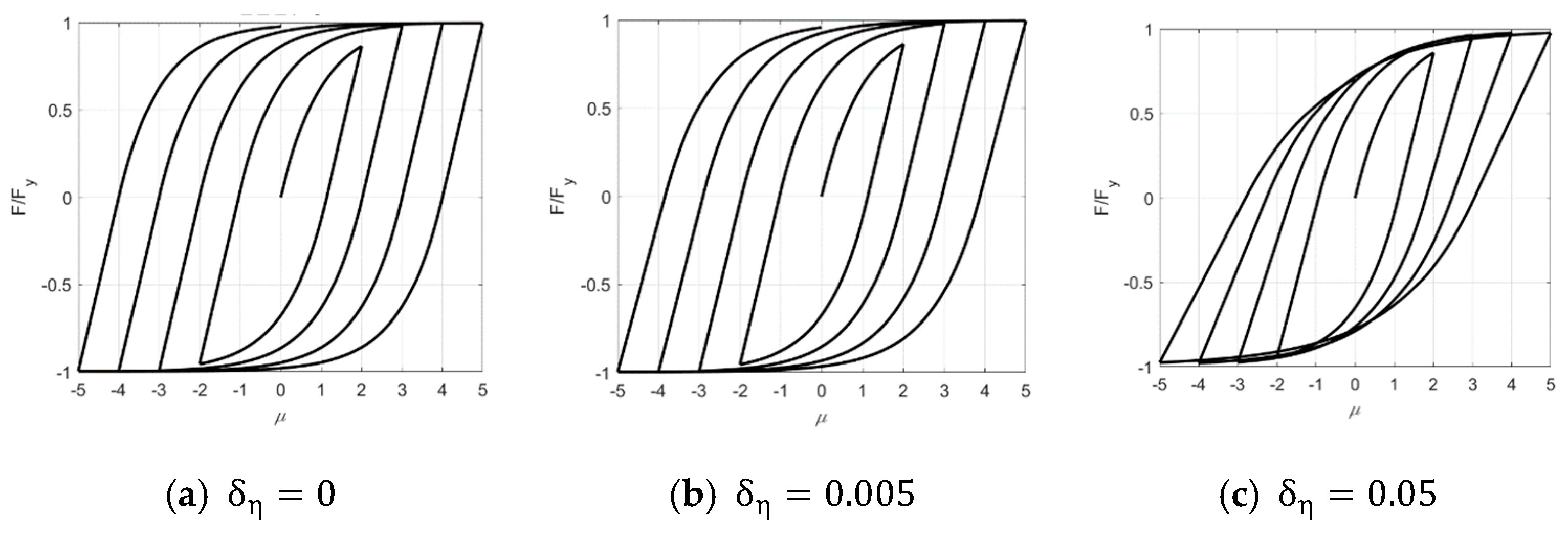



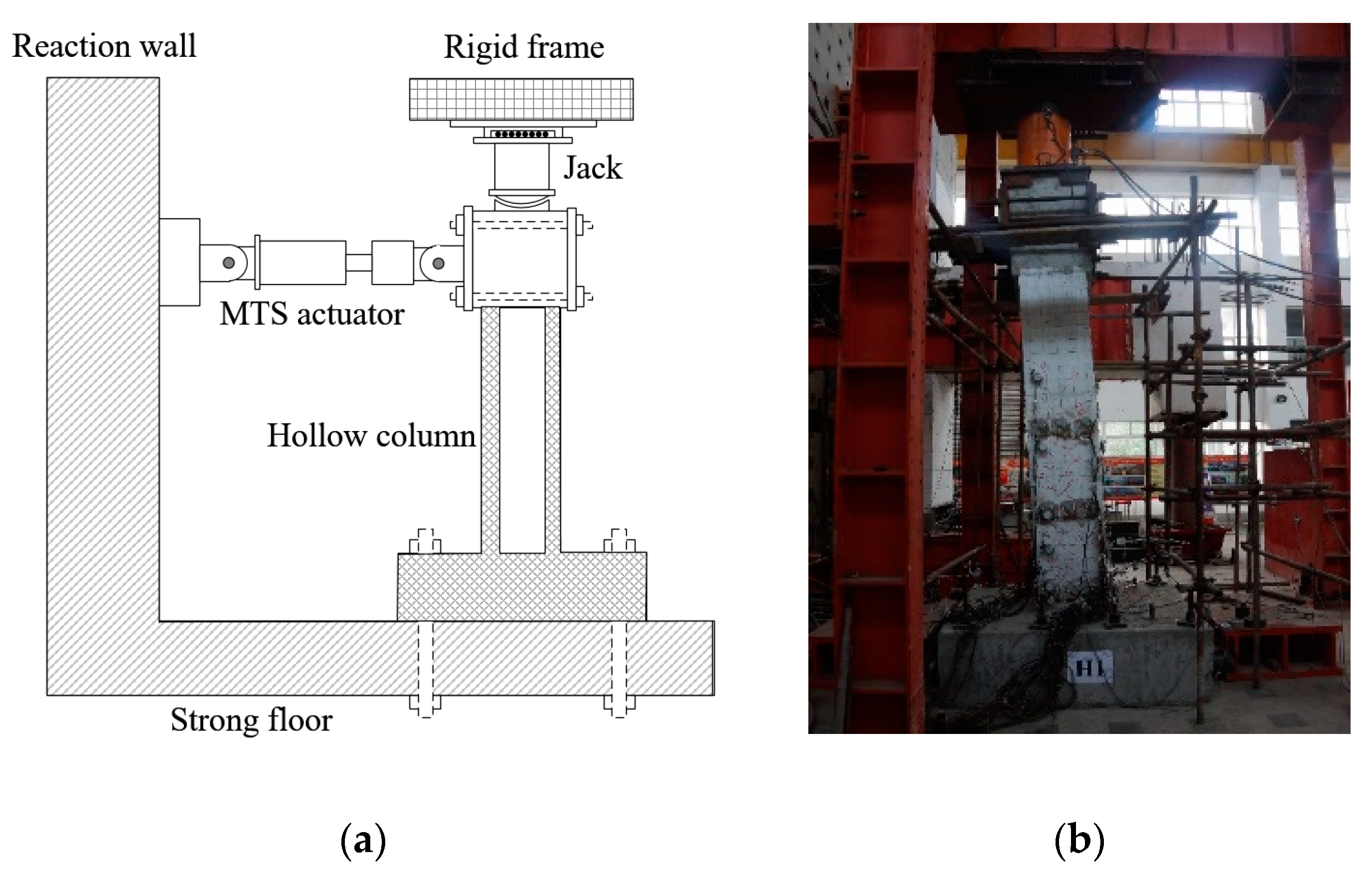
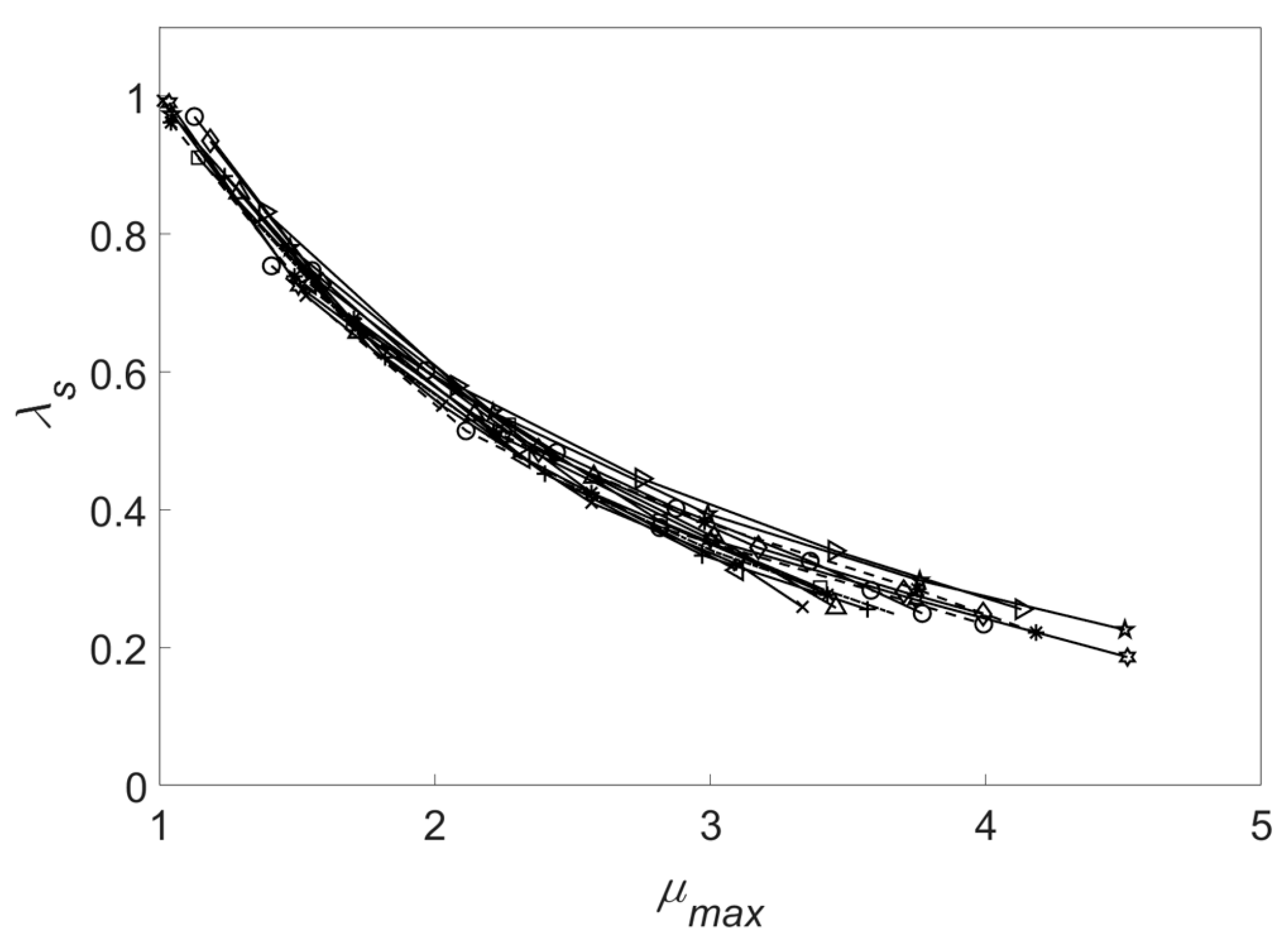
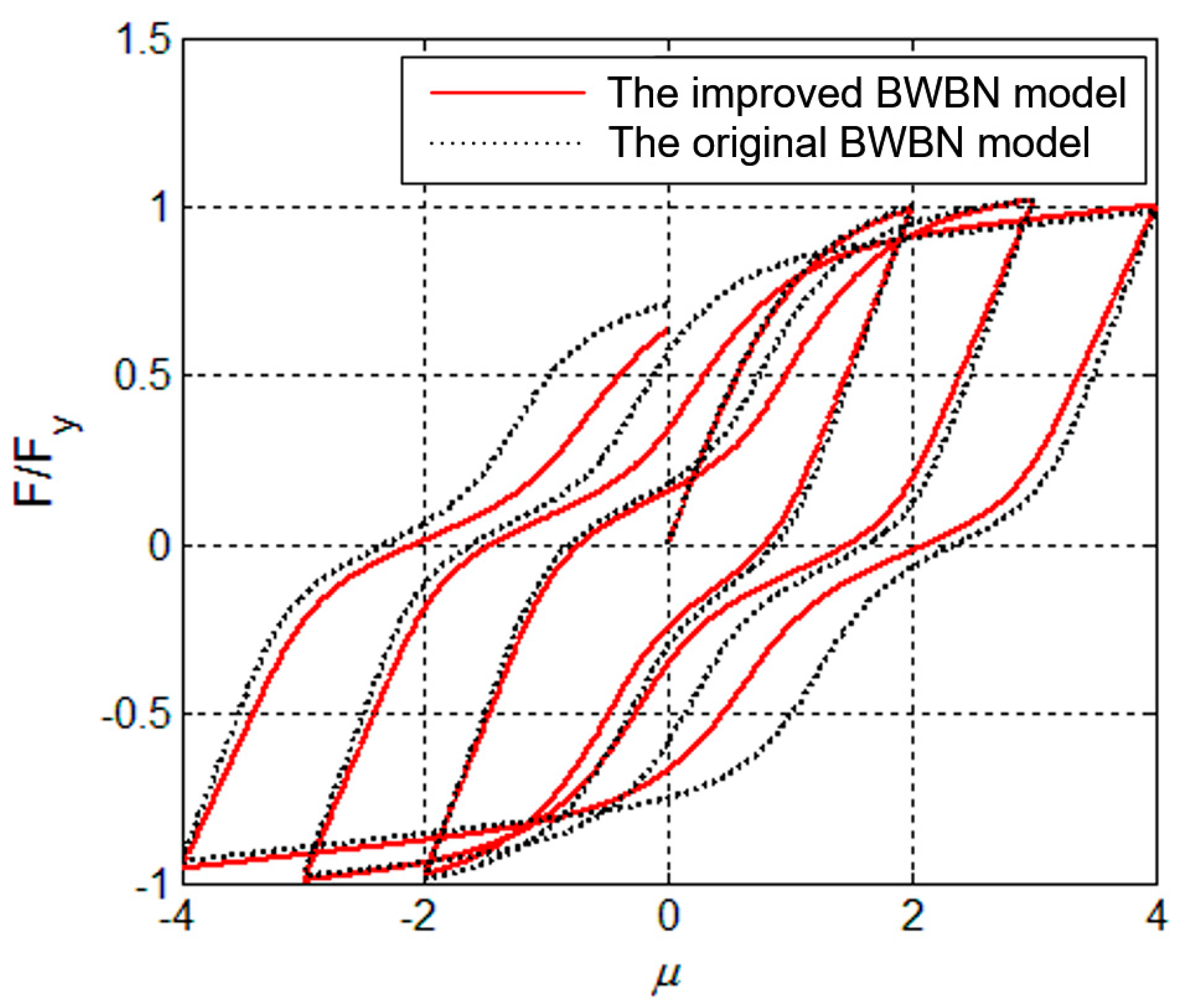

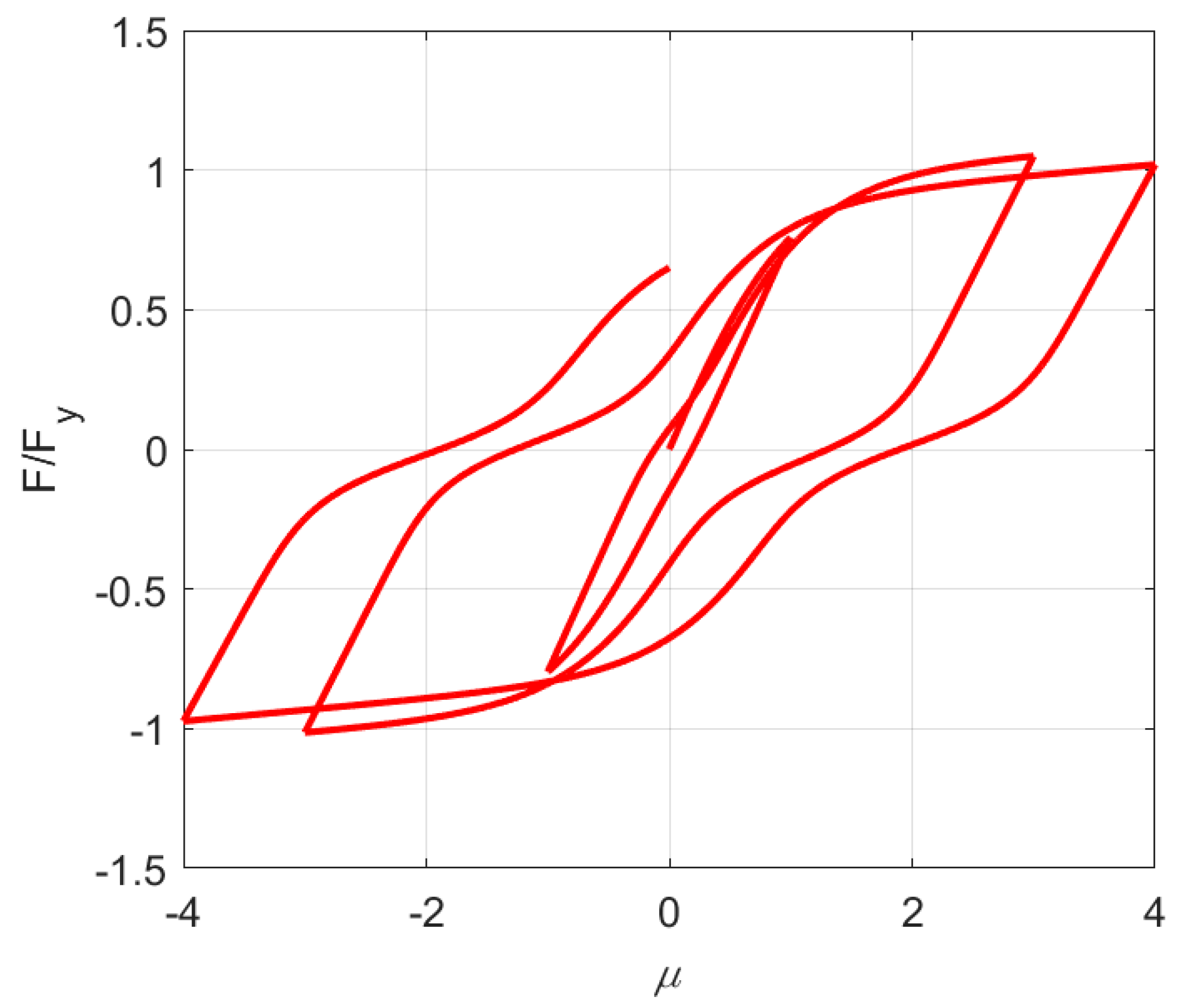
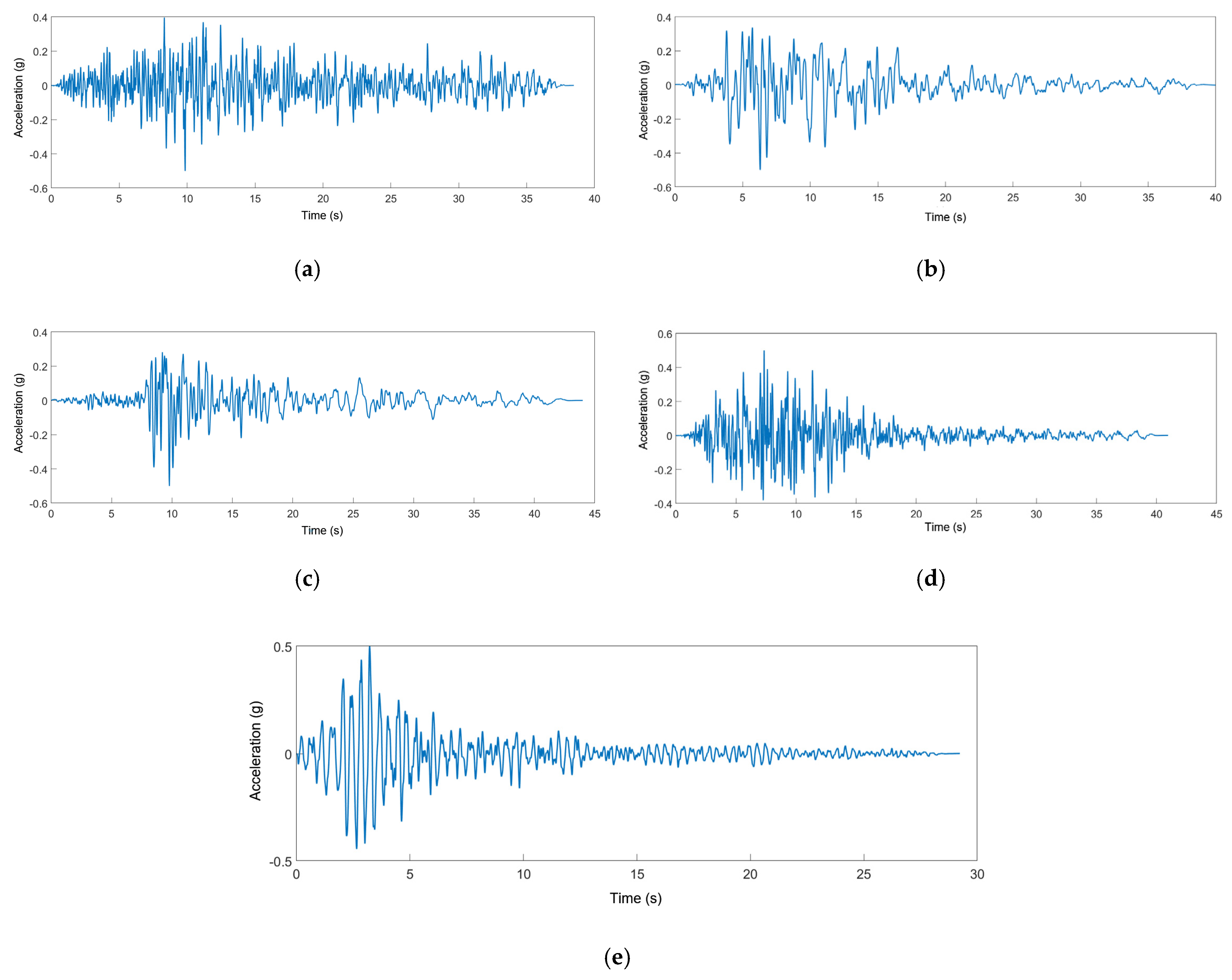

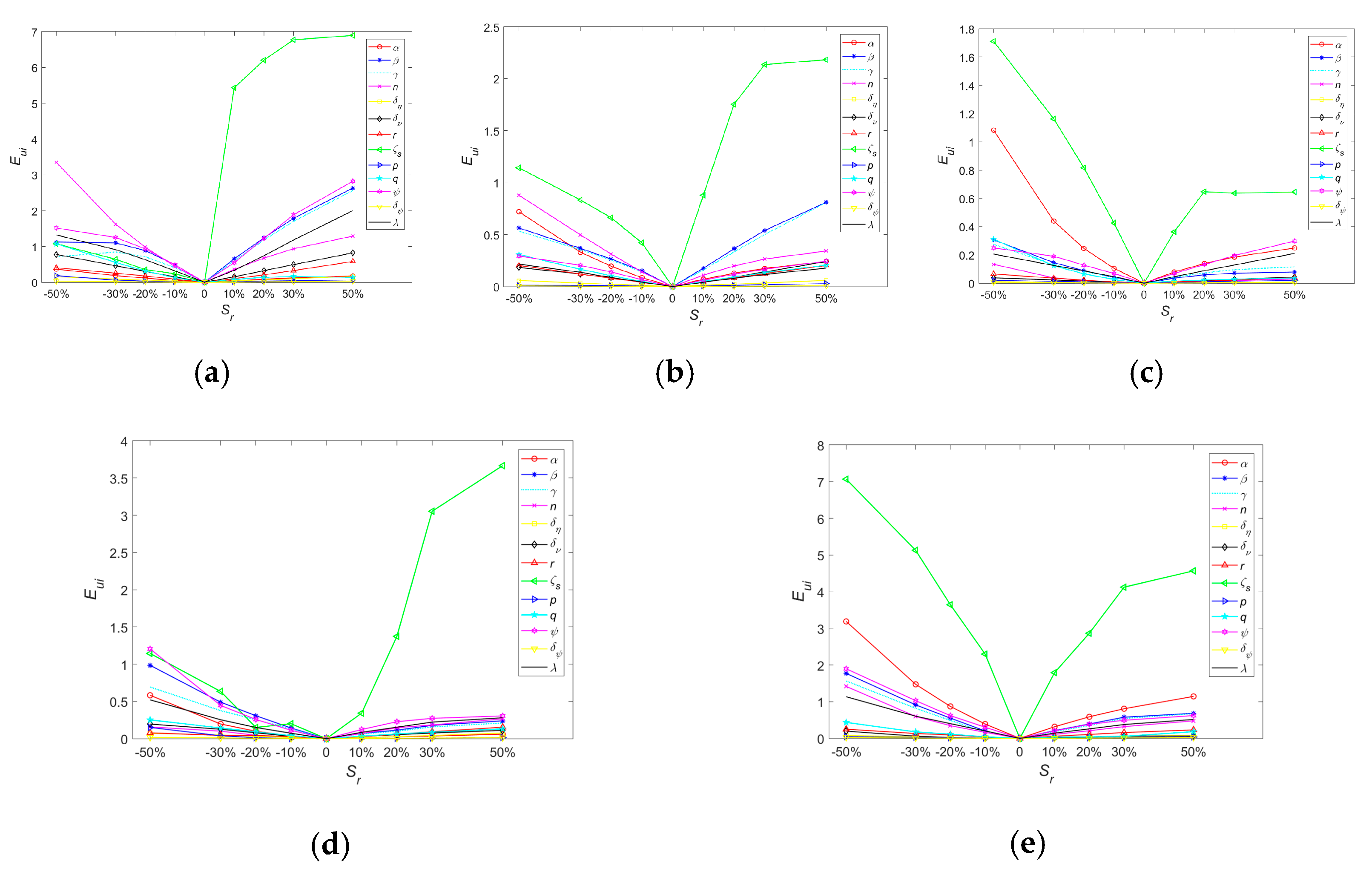
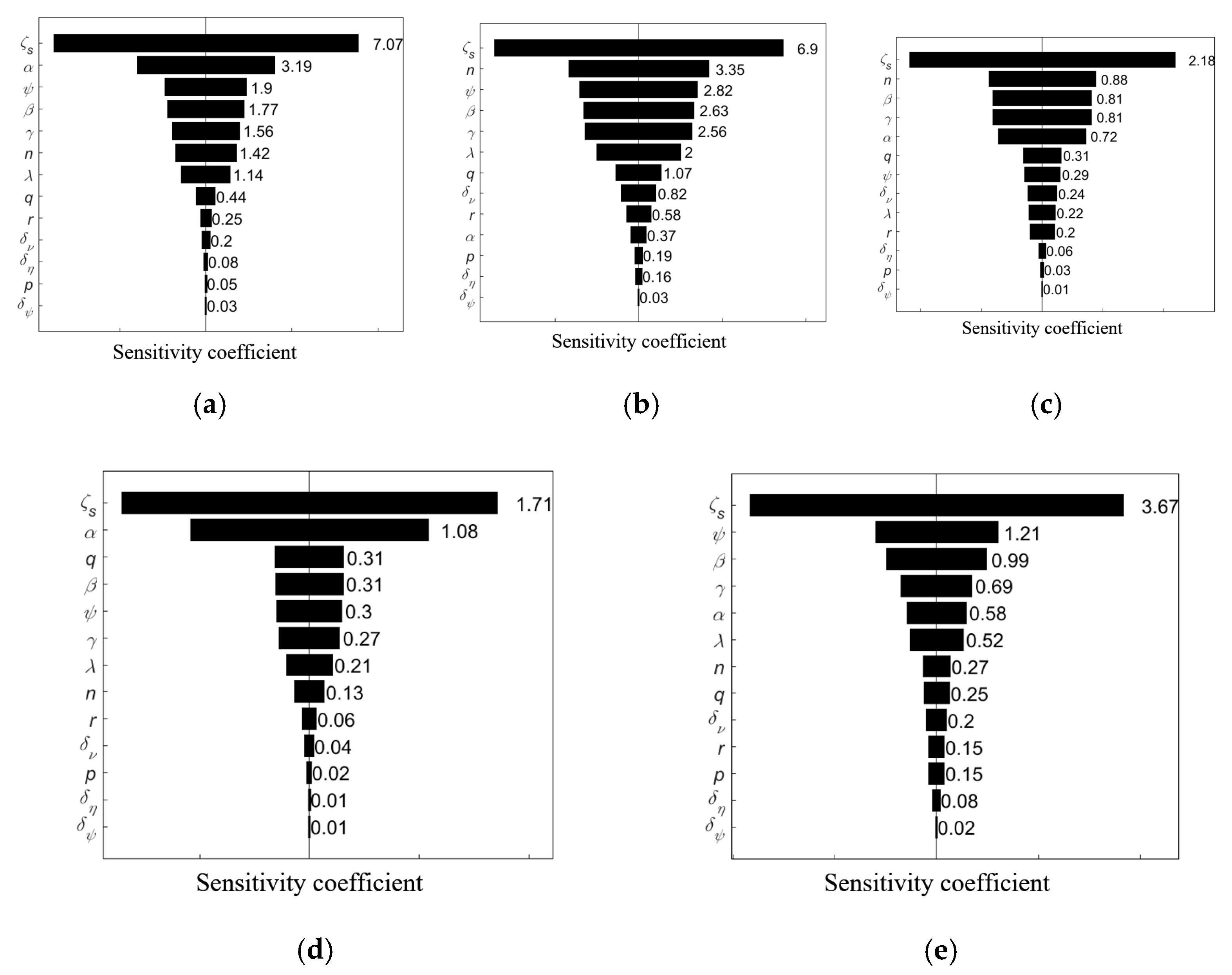
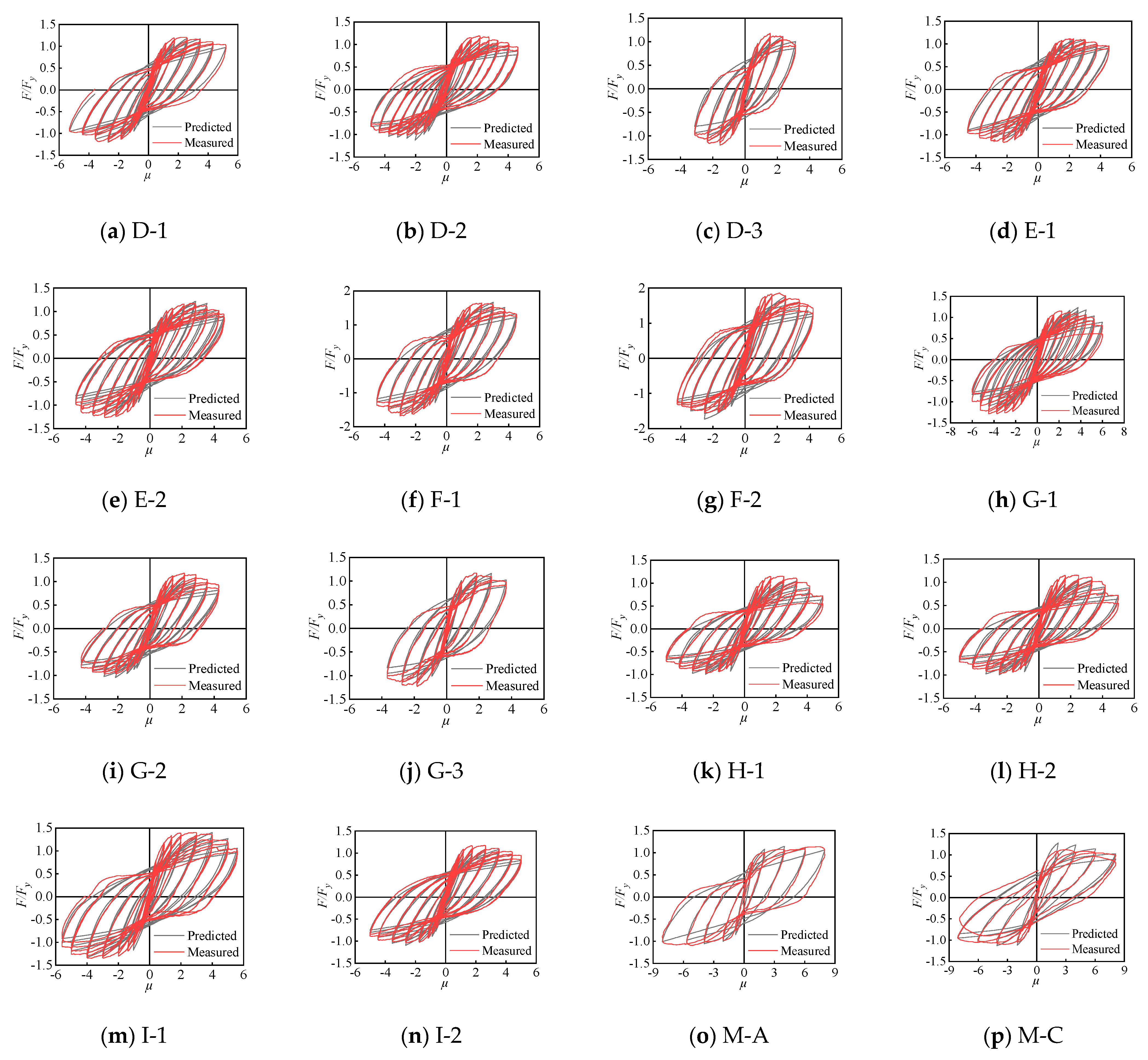

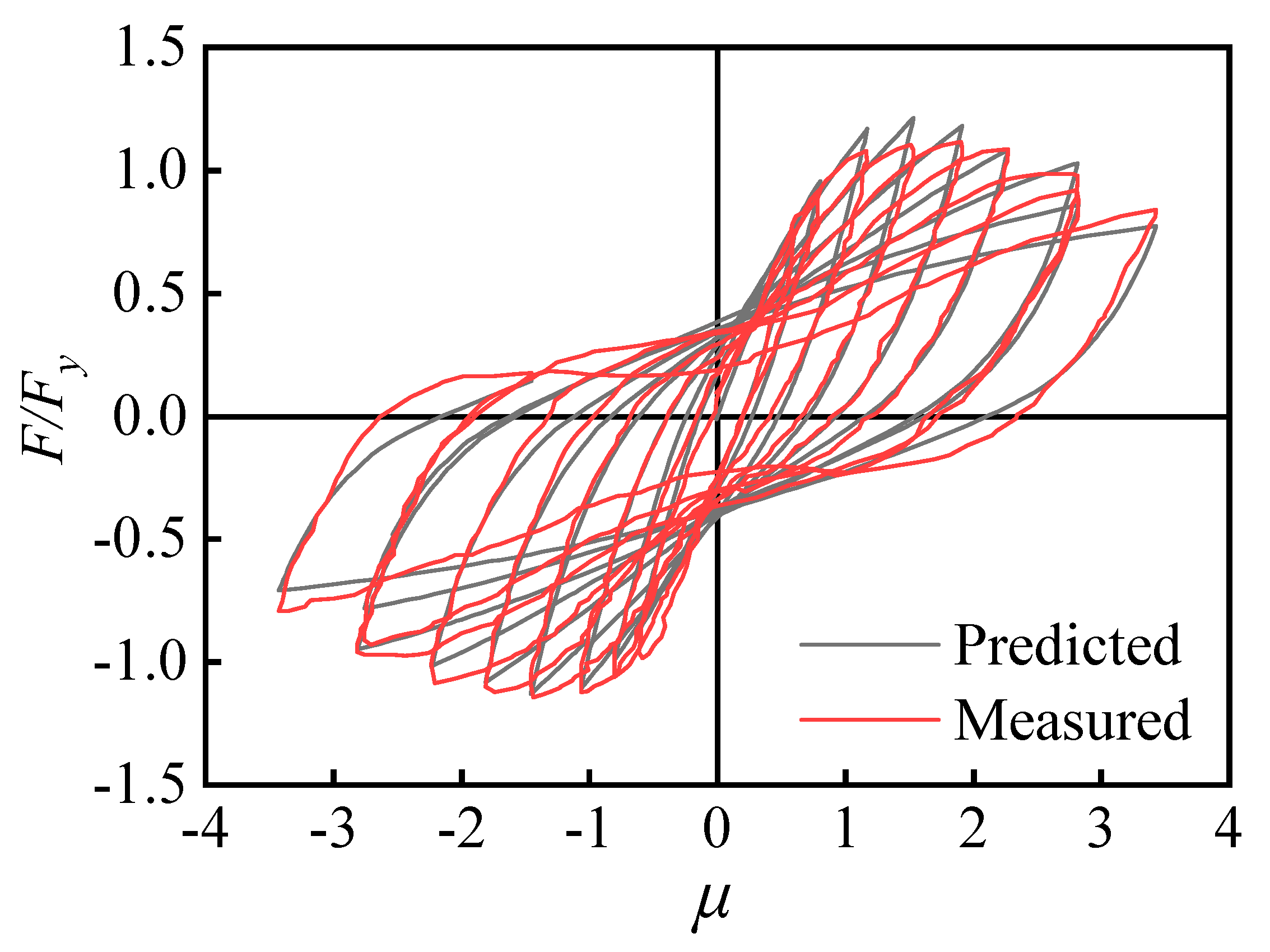

| ID | Depth b1/mm | Width b2/mm | Web Thickness d/mm | Column Height h/mm | Longitudinal Rebar Ratio ρ0/% | Stirrup Ratio ρv/% |
|---|---|---|---|---|---|---|
| D-1 | 500 | 500 | 120 | 1950 | 2.12 | 1.83 |
| D-2 | 500 | 500 | 120 | 2950 | 2.12 | 1.83 |
| D-3 | 500 | 500 | 120 | 3950 | 2.12 | 1.83 |
| E-1 | 500 | 500 | 120 | 2950 | 2.12 | 2.51 |
| E-2 | 500 | 500 | 120 | 2950 | 2.12 | 1.26 |
| F-1 | 500 | 500 | 120 | 2950 | 1.87 | 1.83 |
| F-2 | 500 | 500 | 120 | 2950 | 2.37 | 1.83 |
| G-1 | 500 | 800 | 120 | 1950 | 2.15 | 2.13 |
| G-2 | 500 | 800 | 120 | 2950 | 2.15 | 2.13 |
| G-3 | 500 | 800 | 120 | 3950 | 2.15 | 2.13 |
| H-1 | 500 | 800 | 120 | 2950 | 2.15 | 3.04 |
| H-2 | 500 | 800 | 120 | 2950 | 2.15 | 1.42 |
| I-1 | 500 | 800 | 120 | 2950 | 1.63 | 2.13 |
| I-2 | 500 | 800 | 120 | 2950 | 2.69 | 2.13 |
| No. | Year | Record Name | Moment Magnitude | Rupture Distance/Km | Vs30/(m/s) | PGA/g | Mechanism |
|---|---|---|---|---|---|---|---|
| E1 | 1980 | RSN287_ITALY_A-BOV000 | 6.9 | 46.25 | 356.39 | 0.0464 | Normal |
| E2 | 1989 | RSN731_LOMAP_A10000 | 6.93 | 41.97 | 391.91 | 0.1029 | Reverse oblique |
| E3 | 1992 | RSN826_CAPEMEND_EUR000 | 7.01 | 40.23 | 337.46 | 0.1552 | Reverse |
| E4 | 1995 | RSN1107_KOBE_KAK000 | 6.9 | 22.5 | 312.0 | 0.2476 | Strike slip |
| E5 | 1979 | RSN4459_MONTENE.GRO_VEL000 | 7.1 | 104.24 | 389.54 | 0.2739 | Reverse |
| Parameter | E1 | E2 | E3 | E4 | E5 | |||||
|---|---|---|---|---|---|---|---|---|---|---|
| Rank | Rank | Rank | Rank | Rank | ||||||
| 0.0435 | 3 | 0.0985 | 3 | 0.1410 | 3 | 0.1325 | 4 | 0.1126 | 3 | |
| 0.3916 | 1 | 0.4433 | 1 | 0.4081 | 1 | 0.2700 | 1 | 0.4373 | 1 | |
| 0.2474 | 2 | 0.2561 | 2 | 0.2061 | 2 | 0.1811 | 2 | 0.2869 | 2 | |
| 0.0079 | 7 | 0.0106 | 7 | 0.0159 | 5 | 0.0123 | 7 | 0.0104 | 7 | |
| 0.0003 | 12 | 0.0007 | 11 | 0.0009 | 11 | 0.0016 | 11 | 0.0009 | 10 | |
| 0.0040 | 9 | 0.0053 | 8 | 0.0010 | 10 | 0.0068 | 10 | 0.0007 | 11 | |
| 0.0266 | 6 | 0.0187 | 5 | 0.0015 | 8 | 0.0341 | 5 | 0.0417 | 5 | |
| 0.0267 | 5 | 0.0363 | 4 | 0.0199 | 4 | 0.1349 | 3 | 0.0421 | 4 | |
| 0.0022 | 10 | 0.0003 | 12 | 0.0003 | 13 | 0.0071 | 8 | 0.0012 | 9 | |
| 0.0328 | 4 | 0.0111 | 6 | 0.0081 | 6 | 0.0253 | 6 | 0.0231 | 6 | |
| 0.0076 | 8 | 0.0028 | 9 | 0.0030 | 7 | 0.0068 | 9 | 0.0075 | 8 | |
| 0.0001 | 13 | 0.0002 | 13 | 0.0003 | 12 | 0.0001 | 13 | 0.0000 | 13 | |
| 0.0004 | 11 | 0.0009 | 10 | 0.0013 | 9 | 0.0003 | 12 | 0.0001 | 12 | |
| Parameter | E1 | E2 | E3 | E4 | E5 | |||||
|---|---|---|---|---|---|---|---|---|---|---|
| Rank | Rank | Rank | Rank | Rank | ||||||
| 0.4422 | 1 | 0.7859 | 1 | 0.3592 | 4 | 0.4828 | 3 | 0.4193 | 3 | |
| 0.3739 | 3 | 0.5855 | 3 | 0.5483 | 1 | 0.5305 | 1 | 0.8060 | 1 | |
| 0.3666 | 4 | 0.4447 | 5 | 0.4516 | 2 | 0.4803 | 4 | 0.3157 | 5 | |
| 0.0971 | 8 | 0.1519 | 9 | 0.2118 | 6 | 0.1534 | 6 | 0.0962 | 7 | |
| 0.0027 | 12 | 0.0857 | 10 | 0.0183 | 11 | 0.0523 | 10 | 0.0015 | 13 | |
| 0.0284 | 10 | 0.0007 | 13 | 0.0492 | 10 | 0.0259 | 11 | 0.0133 | 11 | |
| 0.3771 | 2 | 0.7555 | 2 | 0.3773 | 3 | 0.5259 | 2 | 0.4902 | 2 | |
| 0.3198 | 5 | 0.4886 | 4 | 0.2400 | 5 | 0.4648 | 5 | 0.3607 | 4 | |
| 0.1357 | 7 | 0.3521 | 6 | 0.1339 | 8 | 0.1481 | 7 | 0.1006 | 6 | |
| 0.1845 | 6 | 0.2787 | 8 | 0.1684 | 7 | 0.1373 | 8 | 0.0905 | 9 | |
| 0.0518 | 9 | 0.3072 | 7 | 0.0961 | 9 | 0.1017 | 9 | 0.0949 | 8 | |
| 0.0017 | 13 | 0.0031 | 12 | 0.0014 | 13 | 0.0019 | 13 | 0.0016 | 12 | |
| 0.0218 | 11 | 0.0387 | 11 | 0.0177 | 12 | 0.0238 | 12 | 0.0207 | 10 | |
| ID | b1/mm | b2/mm | d/mm | h/mm | ηa | /% | /% | /MPa | /MPa |
|---|---|---|---|---|---|---|---|---|---|
| M-A | 750 | 750 | 120 | 3250 | 0.1 | 1.55 | 0.74 | 335 | 30 |
| M-C | 750 | 750 | 120 | 3250 | 0.3 | 1.55 | 0.83 | 335 | 29 |
| ID | |||||||||||||
|---|---|---|---|---|---|---|---|---|---|---|---|---|---|
| D-1 | 0.07 | 0.75 | −0.06 | 1.15 | 1.04 × 10−5 | 0.08 | 0.06 | 0.63 | 0.46 | 0.05 | 0.57 | 1.58 × 10−4 | 1.73 |
| D-2 | 0.02 | 0.95 | −0.35 | 0.84 | 1.08 × 10−4 | 0.07 | 0.03 | 0.72 | 0.20 | 0.05 | 0.58 | 1.61 × 10−4 | 2.57 |
| D-3 | 0.02 | 1.36 | −0.50 | 0.94 | 1.00 × 10−5 | 0.11 | 0.11 | 0.69 | 0.91 | 0.05 | 0.33 | 1.54 × 10−4 | 4.68 |
| E-1 | 0.06 | 1.34 | −0.26 | 1.74 | 1.00 × 10−5 | 0.11 | 0.05 | 0.61 | 0.71 | 0.09 | 0.37 | 1.54 × 10−4 | 3.91 |
| E-2 | 0.04 | 0.80 | −0.01 | 0.91 | 1.00 × 10−5 | 0.05 | 0.08 | 0.66 | 0.63 | 0.08 | 0.56 | 1.56 × 10−4 | 1.99 |
| F-1 | 0.04 | 1.13 | −0.50 | 1.22 | 5.51 × 10−5 | 0.07 | 0.09 | 0.64 | 0.50 | 0.18 | 0.40 | 1.51 × 10−4 | 4.60 |
| F-2 | 0.04 | 1.21 | −0.49 | 1.73 | 1.00 × 10−5 | 0.09 | 0.10 | 0.59 | 0.75 | 0.14 | 0.31 | 1.57 × 10−4 | 2.80 |
| G-1 | 0.02 | 0.71 | −0.40 | 0.88 | 1.00 × 10−5 | 0.08 | 0.17 | 0.63 | 0.59 | 0.07 | 0.54 | 1.50 × 10−4 | 3.39 |
| G-2 | 0.04 | 0.54 | −0.12 | 1.25 | 2.13 × 10−4 | 0.09 | 0.06 | 0.64 | 0.50 | 0.17 | 0.44 | 1.23 × 10−4 | 1.61 |
| G-3 | 0.03 | 1.26 | −0.46 | 1.14 | 1.09 × 10−5 | 0.11 | 0.12 | 0.66 | 1.02 | 0.28 | 0.35 | 1.48 × 10−4 | 3.80 |
| H-1 | 0.02 | 0.59 | −0.28 | 1.50 | 1.00 × 10−5 | 0.30 | 0.15 | 0.60 | 0.64 | 0.18 | 0.27 | 1.78 × 10−4 | 3.64 |
| H-2 | 0.02 | 0.70 | −0.34 | 0.89 | 2.47 × 10−4 | 0.15 | 0.20 | 0.58 | 0.62 | 0.06 | 0.53 | 1.48 × 10−4 | 4.37 |
| I-1 | 0.03 | 0.90 | −0.50 | 0.93 | 4.92 × 10−5 | 0.06 | 0.15 | 0.61 | 0.41 | 0.06 | 0.62 | 1.74 × 10−4 | 2.76 |
| I-2 | 0.04 | 0.85 | −0.16 | 1.24 | 1.00 × 10−5 | 0.09 | 0.06 | 0.69 | 0.47 | 0.05 | 0.51 | 1.42 × 10−4 | 1.83 |
| M-A | 0.05 | 1.38 | −0.34 | 1.47 | 4.75 × 10−5 | 0.12 | 0.05 | 0.72 | 1.03 | 0.17 | 0.41 | 1.15 × 10−4 | 2.70 |
| M-C | 0.02 | 0.70 | −0.17 | 2.12 | 1.09 × 10−4 | 0.12 | 0.12 | 0.67 | 0.56 | 0.05 | 0.70 | 1.97 × 10−4 | 1.59 |
| Parameters | |||||||||||||
|---|---|---|---|---|---|---|---|---|---|---|---|---|---|
| Lower bound | 0.02 | 0.5 | −0.5 | 0.8 | 1.00 × 10−5 | 0.05 | 0.05 | 0.55 | 0.2 | 0.05 | 0.3 | 1.50 × 10−4 | 1.5 |
| Upper bound | 0.07 | 1.5 | 0 | 2 | 2 × 10−4 | 0.2 | 0.2 | 0.8 | 1 | 0.2 | 0.7 | 2 × 10−4 | 4.6 |
| ID | D-1 | D-2 | D-3 | E-1 | E-2 | F-1 | F-2 | G-1 | G-2 | G-3 | H-1 | H-2 | I-1 | I-2 | M-A | M-C | Mean |
|---|---|---|---|---|---|---|---|---|---|---|---|---|---|---|---|---|---|
| R2 | 0.9786 | 0.9763 | 0.9824 | 0.9878 | 0.9828 | 0.9791 | 0.9758 | 0.9677 | 0.9801 | 0.9821 | 0.9734 | 0.9831 | 0.9828 | 0.9862 | 0.9723 | 0.9742 | 0.9790 |
| E | 0.0007 | 0.0011 | 0.0009 | 0.0008 | 0.001 | 0.0009 | 0.0007 | 0.001 | 0.0008 | 0.001 | 0.0007 | 0.0007 | 0.0008 | 0.0007 | 0.0036 | 0.0029 | 0.0011 |
| −0.993 | −2.600 | −0.172 | −5.049 | 0.372 | 0.298 | 0.122 | −2.473 | |
| −0.524 | −5.445 | 0.169 | −3.676 | 0.000 | 0.150 | 0.116 | −0.051 | |
| −0.310 | −16.783 | 0.261 | −2.943 | −1.211 | 0.202 | −0.265 | 5.768 | |
| −0.436 | −5.623 | 0.003 | 1.451 | 0.412 | 0.424 | 0.090 | −0.397 | |
| 0.194 | 19.570 | 0.086 | −1.908 | 0.212 | 1.000 | 0.838 | −16.067 | |
| 1.151 | 0.725 | −0.035 | 5.272 | −0.519 | −0.266 | −0.304 | −0.305 | |
| −0.043 | 1.485 | 0.018 | −0.443 | 0.071 | −0.016 | 0.071 | −1.447 | |
| 0.618 | 5.006 | 0.316 | −7.662 | −0.093 | 0.475 | 0.624 | −10.946 | |
| 0.245 | −19.424 | −0.114 | 4.005 | −0.307 | −0.340 | −0.607 | 9.579 | |
| −0.226 | −3.248 | 0.150 | −2.645 | −0.423 | 0.160 | −0.031 | 2.237 |
| ID | b1/mm | b2/mm | d/mm | h/mm | η | ||||
|---|---|---|---|---|---|---|---|---|---|
| RC | 360 | 360 | 100 | 1600 | 0.1 | 1.4 | 0.72 | 335 | 38.7 |
| ID | ω0 | α | β | γ | n | δη | δν | r | ζs | p | q | Ψ | δψ |
|---|---|---|---|---|---|---|---|---|---|---|---|---|---|
| RC | 1.25 | 0.03 | 0.55 | −0.11 | 0.56 | 1.18 × 10−4 | 0.14 | 0.12 | 0.71 | 0.34 | 0.07 | 0.2 | 2.15 |
Publisher’s Note: MDPI stays neutral with regard to jurisdictional claims in published maps and institutional affiliations. |
© 2022 by the authors. Licensee MDPI, Basel, Switzerland. This article is an open access article distributed under the terms and conditions of the Creative Commons Attribution (CC BY) license (https://creativecommons.org/licenses/by/4.0/).
Share and Cite
Yang, H.; Li, J.; Shao, C.; Qian, Y.; Qi, Q.; He, J. Parameter Sensitivity Analysis and Identification of an Improved Symmetrical Hysteretic Model for RC Hollow Columns. Symmetry 2022, 14, 945. https://doi.org/10.3390/sym14050945
Yang H, Li J, Shao C, Qian Y, Qi Q, He J. Parameter Sensitivity Analysis and Identification of an Improved Symmetrical Hysteretic Model for RC Hollow Columns. Symmetry. 2022; 14(5):945. https://doi.org/10.3390/sym14050945
Chicago/Turabian StyleYang, Huaping, Jing Li, Changjiang Shao, Yongjiu Qian, Qiming Qi, and Jianxian He. 2022. "Parameter Sensitivity Analysis and Identification of an Improved Symmetrical Hysteretic Model for RC Hollow Columns" Symmetry 14, no. 5: 945. https://doi.org/10.3390/sym14050945







